Markus Freitag
Deconstructing Self-Bias in LLM-generated Translation Benchmarks
Sep 30, 2025Abstract:As large language models (LLMs) begin to saturate existing benchmarks, automated benchmark creation using LLMs (LLM as a benchmark) has emerged as a scalable alternative to slow and costly human curation. While these generated test sets have to potential to cheaply rank models, we demonstrate a critical flaw. LLM generated benchmarks systematically favor the model that created the benchmark, they exhibit self bias on low resource languages to English translation tasks. We show three key findings on automatic benchmarking of LLMs for translation: First, this bias originates from two sources: the generated test data (LLM as a testset) and the evaluation method (LLM as an evaluator), with their combination amplifying the effect. Second, self bias in LLM as a benchmark is heavily influenced by the model's generation capabilities in the source language. For instance, we observe more pronounced bias in into English translation, where the model's generation system is developed, than in out of English translation tasks. Third, we observe that low diversity in source text is one attribution to self bias. Our results suggest that improving the diversity of these generated source texts can mitigate some of the observed self bias.
Generating Difficult-to-Translate Texts
Sep 30, 2025Abstract:Machine translation benchmarks sourced from the real world are quickly obsoleted, due to most examples being easy for state-of-the-art translation models. This limits the benchmark's ability to distinguish which model is better or to reveal models' weaknesses. Current methods for creating difficult test cases, such as subsampling or from-scratch synthesis, either fall short of identifying difficult examples or suffer from a lack of diversity and naturalness. Inspired by the iterative process of human experts probing for model failures, we propose MT-breaker, a method where a large language model iteratively refines a source text to increase its translation difficulty. The LLM iteratively queries a target machine translation model to guide its generation of difficult examples. Our approach generates examples that are more challenging for the target MT model while preserving the diversity of natural texts. While the examples are tailored to a particular machine translation model during the generation, the difficulty also transfers to other models and languages.
Searching for Difficult-to-Translate Test Examples at Scale
Sep 30, 2025Abstract:NLP models require test data that are sufficiently challenging. The difficulty of an example is linked to the topic it originates from (''seed topic''). The relationship between the topic and the difficulty of its instances is stochastic in nature: an example about a difficult topic can happen to be easy, and vice versa. At the scale of the Internet, there are tens of thousands of potential topics, and finding the most difficult one by drawing and evaluating a large number of examples across all topics is computationally infeasible. We formalize this task and treat it as a multi-armed bandit problem. In this framework, each topic is an ''arm,'' and pulling an arm (at a cost) involves drawing a single example, evaluating it, and measuring its difficulty. The goal is to efficiently identify the most difficult topics within a fixed computational budget. We illustrate the bandit problem setup of finding difficult examples for the task of machine translation. We find that various bandit strategies vastly outperform baseline methods like brute-force searching the most challenging topics.
You Cannot Feed Two Birds with One Score: the Accuracy-Naturalness Tradeoff in Translation
Apr 01, 2025Abstract:The goal of translation, be it by human or by machine, is, given some text in a source language, to produce text in a target language that simultaneously 1) preserves the meaning of the source text and 2) achieves natural expression in the target language. However, researchers in the machine translation community usually assess translations using a single score intended to capture semantic accuracy and the naturalness of the output simultaneously. In this paper, we build on recent advances in information theory to mathematically prove and empirically demonstrate that such single-score summaries do not and cannot give the complete picture of a system's true performance. Concretely, we prove that a tradeoff exists between accuracy and naturalness and demonstrate it by evaluating the submissions to the WMT24 shared task. Our findings help explain well-known empirical phenomena, such as the observation that optimizing translation systems for a specific accuracy metric (like BLEU) initially improves the system's naturalness, while ``overfitting'' the system to the metric can significantly degrade its naturalness. Thus, we advocate for a change in how translations are evaluated: rather than comparing systems using a single number, they should be compared on an accuracy-naturalness plane.
Enhancing Human Evaluation in Machine Translation with Comparative Judgment
Feb 25, 2025

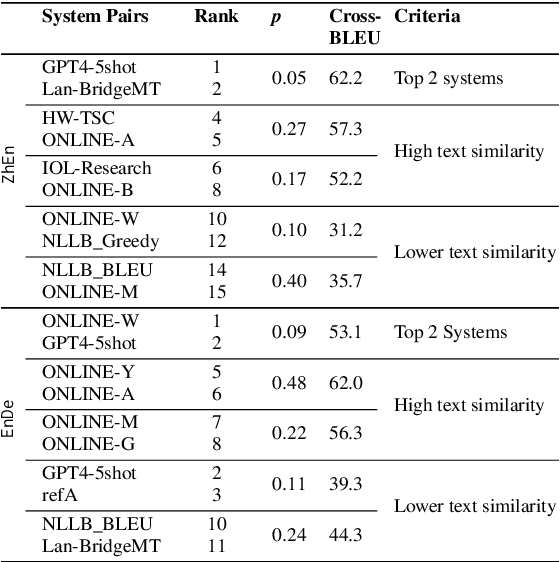
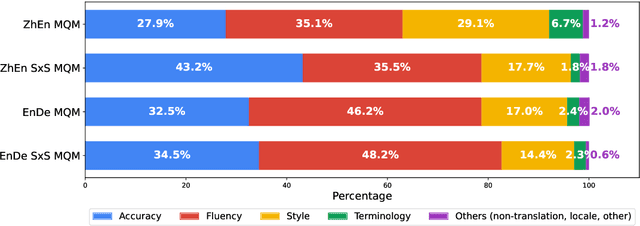
Abstract:Human evaluation is crucial for assessing rapidly evolving language models but is influenced by annotator proficiency and task design. This study explores the integration of comparative judgment into human annotation for machine translation (MT) and evaluates three annotation setups-point-wise Multidimensional Quality Metrics (MQM), side-by-side (SxS) MQM, and its simplified version SxS relative ranking (RR). In MQM, annotators mark error spans with categories and severity levels. SxS MQM extends MQM to pairwise error annotation for two translations of the same input, while SxS RR focuses on selecting the better output without labeling errors. Key findings are: (1) the SxS settings achieve higher inter-annotator agreement than MQM; (2) SxS MQM enhances inter-translation error marking consistency compared to MQM by, on average, 38.5% for explicitly compared MT systems and 19.5% for others; (3) all annotation settings return stable system rankings, with SxS RR offering a more efficient alternative to (SxS) MQM; (4) the SxS settings highlight subtle errors overlooked in MQM without altering absolute system evaluations. To spur further research, we will release the triply annotated datasets comprising 377 ZhEn and 104 EnDe annotation examples.
WMT24++: Expanding the Language Coverage of WMT24 to 55 Languages & Dialects
Feb 18, 2025Abstract:As large language models (LLM) become more and more capable in languages other than English, it is important to collect benchmark datasets in order to evaluate their multilingual performance, including on tasks like machine translation (MT). In this work, we extend the WMT24 dataset to cover 55 languages by collecting new human-written references and post-edits for 46 new languages and dialects in addition to post-edits of the references in 8 out of 9 languages in the original WMT24 dataset. The dataset covers four domains: literary, news, social, and speech. We benchmark a variety of MT providers and LLMs on the collected dataset using automatic metrics and find that LLMs are the best-performing MT systems in all 55 languages. These results should be confirmed using a human-based evaluation, which we leave for future work.
Overestimation in LLM Evaluation: A Controlled Large-Scale Study on Data Contamination's Impact on Machine Translation
Jan 30, 2025



Abstract:Data contamination -- the accidental consumption of evaluation examples within the pre-training data -- can undermine the validity of evaluation benchmarks. In this paper, we present a rigorous analysis of the effects of contamination on language models at 1B and 8B scales on the machine translation task. Starting from a carefully decontaminated train-test split, we systematically introduce contamination at various stages, scales, and data formats to isolate its effect and measure its impact on performance metrics. Our experiments reveal that contamination with both source and target substantially inflates BLEU scores, and this inflation is 2.5 times larger (up to 30 BLEU points) for 8B compared to 1B models. In contrast, source-only and target-only contamination generally produce smaller, less consistent over-estimations. Finally, we study how the temporal distribution and frequency of contaminated samples influence performance over-estimation across languages with varying degrees of data resources.
From Jack of All Trades to Master of One: Specializing LLM-based Autoraters to a Test Set
Nov 23, 2024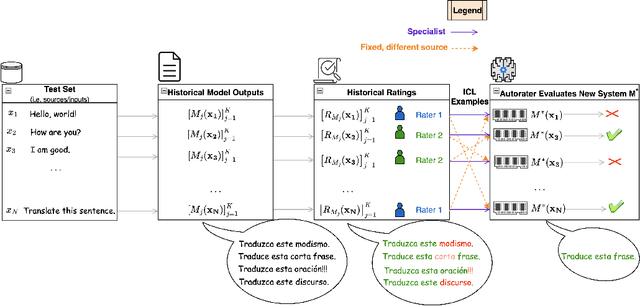



Abstract:As LLMs continue to become more powerful and versatile, human evaluation has quickly become intractable at scale and reliance on automatic metrics has become the norm. Recently, it has been shown that LLMs are themselves state-of-the-art evaluators for many tasks. These Autoraters are typically designed so that they generalize to new systems and test sets. In practice, however, evaluation is performed on a small set of fixed, canonical test sets, which are carefully curated to measure certain capabilities of interest and are not changed frequently. In this work, we design a method which specializes a prompted Autorater to a given test set, by leveraging historical ratings on the test set to construct in-context learning (ICL) examples. We evaluate our Specialist method on the task of fine-grained machine translation evaluation, and show that it dramatically outperforms the state-of-the-art XCOMET metric by 54% and 119% on the WMT'23 and WMT'24 test sets, respectively. We perform extensive analyses to understand the representations learned by our Specialist metrics, and how variability in rater behavior affects their performance. We also verify the generalizability and robustness of our Specialist method for designing automatic metrics across different numbers of ICL examples, LLM backbones, systems to evaluate, and evaluation tasks.
Mitigating Metric Bias in Minimum Bayes Risk Decoding
Nov 05, 2024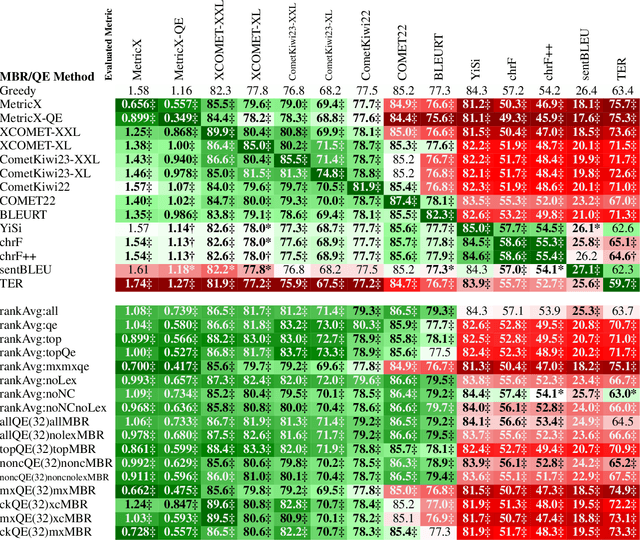
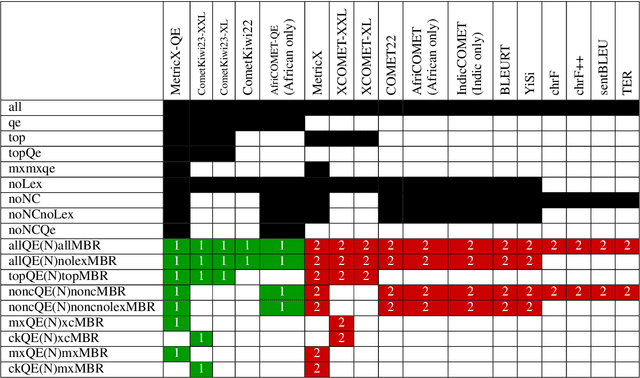
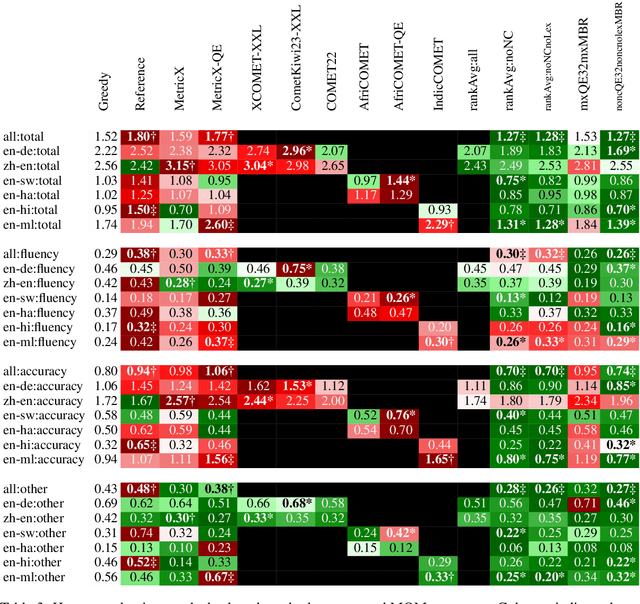
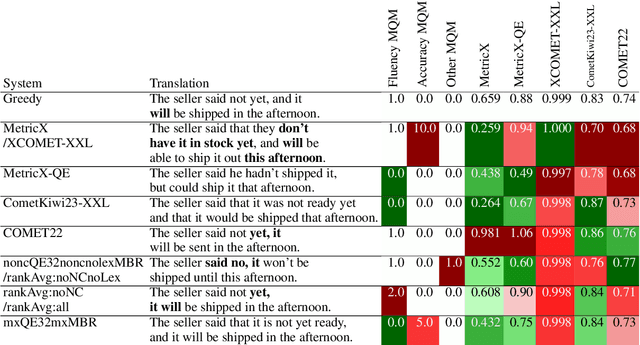
Abstract:While Minimum Bayes Risk (MBR) decoding using metrics such as COMET or MetricX has outperformed traditional decoding methods such as greedy or beam search, it introduces a challenge we refer to as metric bias. As MBR decoding aims to produce translations that score highly according to a specific utility metric, this very process makes it impossible to use the same metric for both decoding and evaluation, as improvements might simply be due to reward hacking rather than reflecting real quality improvements. In this work we find that compared to human ratings, neural metrics not only overestimate the quality of MBR decoding when the same metric is used as the utility metric, but they also overestimate the quality of MBR/QE decoding with other neural utility metrics as well. We also show that the metric bias issue can be mitigated by using an ensemble of utility metrics during MBR decoding: human evaluations show that MBR decoding using an ensemble of utility metrics outperforms a single utility metric.
Learning from others' mistakes: Finetuning machine translation models with span-level error annotations
Oct 21, 2024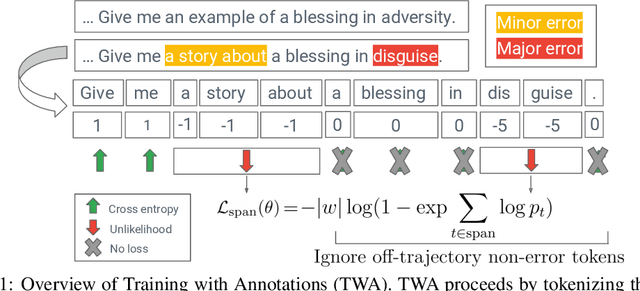



Abstract:Despite growing interest in incorporating feedback to improve language models, most efforts focus only on sequence-level annotations. In this work, we explore the potential of utilizing fine-grained span-level annotations from offline datasets to improve model quality. We develop a simple finetuning algorithm, called Training with Annotations (TWA), to directly train machine translation models on such annotated data. TWA utilizes targeted span-level error information while also flexibly learning what to penalize within a span. Moreover, TWA considers the overall trajectory of a sequence when deciding which non-error spans to utilize as positive signals. Experiments on English-German and Chinese-English machine translation show that TWA outperforms baselines such as Supervised FineTuning on sequences filtered for quality and Direct Preference Optimization on pairs constructed from the same data.
 Add to Chrome
Add to Chrome Add to Firefox
Add to Firefox Add to Edge
Add to Edge